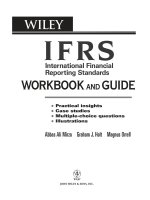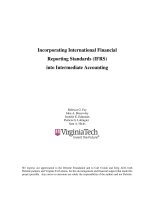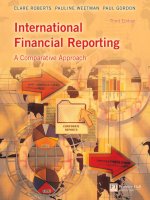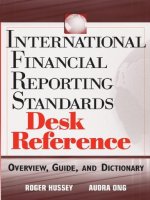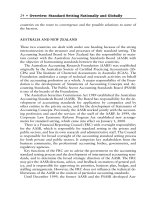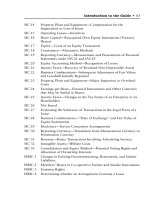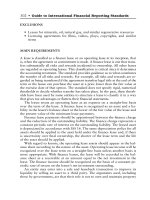International financial reporting standards
Bạn đang xem bản rút gọn của tài liệu. Xem và tải ngay bản đầy đủ của tài liệu tại đây (2.01 MB, 407 trang )
I F RS
I F RS
WORKBOOK
AND
GUIDE
International Financial
Reporting Standards
Wiley
■
Practical insights
■
Case studies
■
Multiple-choice questions
■
Illustrations
Abbas Ali Mirza Graham J. Holt Magnus Orrell
JOHN WILEY & SONS, INC.
I F RS
I F RS
WORKBOOK
AND
GUIDE
International Financial
Reporting Standards
Wiley
I F RS
I F RS
WORKBOOK
AND
GUIDE
International Financial
Reporting Standards
Wiley
■
Practical insights
■
Case studies
■
Multiple-choice questions
■
Illustrations
Abbas Ali Mirza Graham J. Holt Magnus Orrell
JOHN WILEY & SONS, INC.
Portions of this book have their origins in copyrighted materials from the International Accounting Standards
Board. These are noted by reference to the specific pronouncements, except for certain of the definitions
introduced in bold type, which appear in a separate section at the beginning of each chapter. Complete
copies of the international standards are available from the IASB. Copyright © International Accounting
Standards Board, 30 Cannon Street, London EC4M 6XH, United Kingdom.
This book is printed on acid-free paper.
∞
Copyright © 2006 by John Wiley & Sons, Inc. All rights reserved.
Published by John Wiley & Sons, Inc., Hoboken, New Jersey
Published simultaneously in Canada.
No part of this publication may be reproduced, stored in a retrieval system, or transmitted in any form or by
any means, electronic, mechanical, photocopying, recording, scanning, or otherwise, except as permitted
under Section 107 or 108 of the 1976 United States Copyright Act, without either the prior written
permission of the Publisher, or authorization through payment of the appropriate per-copy fee to the
Copyright Clearance Center, 222 Rosewood Drive, Danvers, MA 01923, (978)750-8400, fax (978)750-4470,
or on the Web at www.copyright.com. Requests to the Publisher for permission should be addressed to the
Permissions Department, John Wiley & Sons, Inc., 111 River Street, Hoboken, NJ 07030, (201)748-6011,
fax (201)748-6008, or online at
Limit of Liability/Disclaimer of Warranty: While the publisher and author have used their best efforts in
preparing this book, they make no representations or warranties with respect to the accuracy or completeness
of the contents of this book and specifically disclaim any implied warranties of merchantability or fitness for
a particular purpose. No warranty may be created or extended by sales representatives or written sales
materials. The advice and strategies contained herein may not be suitable for your situation. You should
consult with a professional where appropriate. Neither the publisher nor author shall be liable for any loss of
profit or any other commercial damages, including but not limited to special, incidental, consequential, or
other damages.
For general information on our other products and services, please contact our Customer Care Department
within the US at 800-762-2974, outside the US at 317-572-3993 or fax 317-572-4002.
Wiley also publishes its books in a variety of electronic formats. Some content that appears in print may not
be available in electronic books. For more information about Wiley products, visit our Web site at
www.wiley.com.
ISBN 13: 978-0471-69742-8
ISBN 10: 0-471-69742-7
Printed in the United States of America
10 9 8 7 6 5 4 3 2 1
CONTENTS
Chapter Title Page No.
1 Introduction to International Financial Reporting Standards 1
2 IASB Framework 7
3 Presentation of Financial Statements (IAS 1) 12
4 Inventories (IAS 2) 20
5 Cash Flow Statements (IAS 7) 27
6 Accounting Policies, Changes in Accounting Estimates and Errors (IAS 8) 39
7 Events After the Balance Sheet Date (IAS 10) 48
8 Construction Contracts (IAS 11) 53
9 Income Taxes (IAS 12) 62
10 Segment Reporting (IAS 14) 75
11 Property, Plant, and Equipment (IAS 16) 85
12 Leases (IAS 17) 93
13 Revenue (IAS 18) 103
14 Employee Benefits (IAS19) 110
15
Accounting for Government Grants and Disclosure of Government
Assistance (IAS 20)
122
16 The Effects of Changes in Foreign Exchange Rates (IAS 21) 129
17 Borrowing Costs (IAS 23) 138
18 Related Party Disclosures (IAS 24) 144
19 Accounting and Reporting by Retirement Benefit Plans (IAS 26) 152
20 Consolidated and Separate Financial Statements ( IAS 27) 159
21 Investments in Associates (IAS 28) 166
22 Financial Reporting in Hyperinflationary Economies (IAS 29) 172
23
Disclosures in the Financial Statements of Banks and Similar Financial
Institutions (IAS 30)
177
24 Interests in Joint Ventures (IAS 31) 182
25 Financial Instruments: Presentation (IAS 32) 187
26 Financial Instruments: Recognition and Measurement (IAS 39) 203
27 Earnings Per Share (IAS 33) 248
28 Interim Financial Reporting (IAS 34) 260
29 Impairment of Assets (IAS 36) 264
30 Provisions, Contingent Liabilities, and Contingent Assets (IAS 37) 276
31 Intangible Assets (IAS 38) 287
32 Investment Property (IAS 40) 298
33 Agriculture (IAS 41) 306
34 First-Time Adoption of International Financial Reporting Standards (IFRS 1) 314
35 Share-Based Payments (IFRS 2) 326
36 Business Combinations (IFRS 3) 338
37 Insurance Contracts (IFRS 4) 350
38 Noncurrent Assets Held for Sale and Discontinued Operations (IFRS 5) 356
39 Exploration for and Evaluation of Mineral Resources (IFRS 6) 365
40 Financial Instruments: Disclosures (IFRS 7) 371
Index 380
FOREWORD
by the Chairman of IASB
I and my fellow Board members at the International Accounting Standards Board (IASB) are committed
to developing high quality, understandable, and enforceable global accounting standards that meet the de-
mands for comparable and transparent information in the world’s capital markets. Recently we completed a
work program to develop and issue a stable platform of such standards. Those standards, the International
Financial Reporting Standards (IFRS), are now being implemented in a large number of countries around the
world. This is a major achievement on the road towards the global acceptance of a single set of accounting
standards.
The responsibility for achieving high quality financial reporting, however, does not rest solely with
IASB. Our role is limited to providing the set of standards that entities should apply to achieve high quality,
comparable, and transparent financial reporting. For IFRS to be properly understood, implemented, and ap-
plied in practice, education and training of all relevant parties—including financial statement preparers,
auditors, regulators, financial analysts, and other users of financial statements as well as accounting
students—is essential.
This book should be a helpful tool in this regard. The approach of the book is to discuss core concepts
and other key elements of the standards and to provide training material in the form of worked case studies
and questions to support successful learning of the material. Consequently, the book should be useful for
students who prepare for professional exams and for financial statement preparers, auditors, regulators, fi-
nancial analysts, and other users of financial statements who in their work need to be familiar with the stan-
dards. The book should help practitioners and students alike understand, implement, and apply the key ele-
ments of the standards.
Sir David Tweedie
Chairman of IASB
December, 2005
FOREWORD
by the Secretary General of IOSCO
In recent years much has been written about International Financial Reporting Standards (IFRS) so it is
opportune that a publication such as this would be released at this time particularly since this initiative helps
to bring such clarity and focus to the debate.
Globalization is taking place at an ever more rapid pace. As cross-border financial activity increases,
capital markets become more dependent on each other. As financial markets become ever more interdepend-
ent, there is a greater need for the development of internationally recognized and accepted standards dealing
with capital market regulation.
The development of IFRS can be seen within this broader framework. They represent an especially use-
ful instrument designed to promote a stable and more secure international regulatory environment. At the
same time, IFRS deliver on accounting and disclosure objectives as well as the pursuit of improved transpar-
ency of global financial reporting.
For the International Organization of Securities Commissions (IOSCO), the development and subsequent
progress of IFRS represents a priority outcome. The organization has been a key stakeholder with an active
involvement in the process of setting the standards and in continually assessing their quality.
This involvement reflects a long history of commitment by IOSCO to efforts aimed at strengthening the
integrity of international markets through the promotion of high quality accounting standards, including rig-
orous application and enforcement.
At the same time, there is an obligation of international standard setters to be responsive to concerns
over the application and interpretation of the standards. This is a key complement to the success of IFRS and
one which we take seriously.
Ultimately, accounting standards setting is a continuous process that must respond to changes and devel-
opments in the markets and the information needs of investors. Indeed, it has always been the case that ef-
fective financial reporting is fundamental to investor confidence as well as good corporate governance.
In the long term, the adoption of IFRS in many countries and their use in numerous cross-border trans-
actions will help to bring about these high quality global accounting standards by providing transparent and
comparable information in financial reports.
Although as an international standards setter IOSCO is not in position to endorse external publications,
we have always recognized that by helping to promote clear information about the IFRS, publications such as
this one serve a particularly useful function both as an educational opportunity and also to encourage confi-
dence in these standards. On that basis it is most welcome.
Philippe Richard
IOSCO Secretary General
March 2006
PREFACE
Achieving consistency in financial reporting worldwide is the need of the hour, especially if meaningful
comparisons are to be made of financial information emanating from different countries using accounting
standards that, until recently, were vastly different from each other. Thus, there has arisen the urgent need for
promulgation of a common set of global accounting standards or, in other words, global convergence into a
common language of accounting for the financial world. International Financial Reporting Standards (IFRS),
the standards promulgated by the International Accounting Standards Board (IASB), previously known as
International Accounting Standards (IAS) that were issued by the International Accounting Standard
Committee (IASC), the IASB’s predecessor body, appear to be emerging as the global accounting standards
and, according to some, could even qualify for the coveted title of “the Esperanto of accounting.”
This is a challenging and exciting time to be writing a book on IFRS. Challenging, because it is indeed a
daunting task to publish a book on a body of knowledge such as IFRS, which is undergoing significant
changes at an unprecedented pace. In some cases, changes were made to certain IASB standards within the
same year, and thus we, as authors, had to revise chapters when amendments to existing standards were
announced. In certain cases, even after chapters were initially written and finalized, in order to keep the book
current, we had to rewrite parts. Yet this is also an exciting time to be writing a book on a subject of global
importance such as IFRS, since the IASB standards are rapidly being adopted in a large number of countries
all around the world. For instance, by the time this book goes to print, most countries in Europe, including all
of the 25 member states of the European Union, will require listed companies to prepare their consolidated
financial statements in accordance with IFRS instead of local requirements, and many countries in Africa,
Asia, Australia, and the Americas are adopting IFRS as their national accounting standards. Knowing full
well that the book will have to cater to the requirements of users globally made the task of writing even more
challenging.
Whether you are an accountant, auditor, investor, banker, regulator, or financial analyst, understanding
and appreciating the fundamental principles and requirements of IFRS has become more important than ever
before. In this new financial world, knowledge of the fundamental principles of IFRS is essential to meet the
growing demands of a changing regulatory and market environment. Cognizant of that, we embarked on this
book project to help users and preparers of IFRS financial statements alike.
We have written this book with the end user in mind, which should make it user-friendly. For instance, if
you are an accountant or an auditor working in a country that has recently adopted IFRS (say, one of the
countries in the European Union), you are now faced with the challenges of being able to apply these
standards and to read and understand financial statements prepared in accordance with them. This book will
help you to do that. We believe that this book’s real strength lies in the fact that it explains the IASB
standards in a lucid manner so even first-time adopters of IFRS can understand the subject. The book
illustrates the practical application of the IASB standards using easy-to-apply illustrations and simple
examples. It goes a step further and provides copious learning aids in the form of case studies (with worked
solutions), multiple-choice questions (with answers), and practical insights. We hope its simple, step-by-step
approach will guide you in the application of IFRS.
In general, the structure and contents of the book are consistent with the order and scope of each
standard; each chapter discusses a specific IFRS, and the chapters are ordered consistent with the numbering
of the IFRS currently in effect. This structure allows you to use the book as a handbook, side by side with the
bound volume of standards issued by IASB. The only exception is the chapter on IAS 39, which is located
immediately after the chapter on IAS 32 in this book, since both standards address the same topic: the
accounting for financial instruments. Also, the chapters dealing with IAS precede the chapters dealing with
IFRS.
We hope that this book will greatly facilitate learning and will also help readers to understand the
technical complexities of the standards. Although a great deal of effort has gone into writing this book, we
sincerely believe that there is always scope for improvement. Any suggestions and comments for future
editions are therefore encouraged. We humbly submit that any views expressed in this publication are ours
alone and do not necessarily represent those of the firms or organizations we are part of.
Finally, we wish all our readers a very educating journey through the book.
Abbas Ali Mirza
Graham Holt
Magnus Orrell
March 2006
